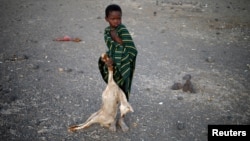Prominent Kenyans shared pictures of drought-hit communities on Twitter on Tuesday, calling for greater government action to end a hunger crisis which has left 1 million people short of food.
#WeCannotIgnore was trending in the east African nation as human rights activists, journalists and ordinary citizens shared images of a child begging for water and elderly people in arid counties, like Turkana, where drought is a recurrent problem.
"If hunger is not killing them, then Govt must immediately stop these Turkanas from working themselves out to death in their air-conditioned gyms," tweeted journalist Linus Kaikai, with a photograph of an emaciated old man sitting in a mud hut.
"When I look at my paycheck and see how much the government takes away from me; and millions others ... there is more than enough to feed famine stricken Kenyans," said sports presenter Carol Radull on Twitter.
"Stop wasting time and use my taxes properly!" Kenya is hit by drought every few years and has struggled to prevent hunger despite numerous projects to bolster people living in arid lands who traditionally depend on livestock.
The number of people in need of food aid has risen by almost 70 percent to 1.1 million since August due to poor rains in October and November, the government says.
In northern regions such as Turkana and Garissa, not only have the lack of rains caused crops to fail, but also triggered conflicts between herders over scarce water and pasture.
Local media have reported deaths linked to a lack of food in some counties, but government officials say they have no confirmed reports associated with the drought.
In 2017, the government declared drought a national disaster and appealed for aid for 2.7 million people without food.
The National Drought Management Authority, a government agency managed to prevent emergencies, described the current situation as "stable," as the country's main rainy season is due to begin within weeks.
"The food security situation has deteriorated in the pastoral and marginal agriculture livelihood zones following the poor performance of the 2018 short (October and November) rains," it said in a report this month.
"(But) the effect of this was not as large as it might have been because the 2018 long rains led to substantial regeneration of pasture and higher crop production, and consequently improved food and nutrition security."
Kenya's Deputy President William Ruto on Monday announced that the government has allocated 2 billion shillings ($19.85 million) to respond to the drought.
"Funds will ensure adequate distribution of food, life-saving aid to needy populations, water trucking and complement first-line interventions by county governments," he said on Twitter.











